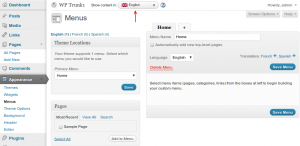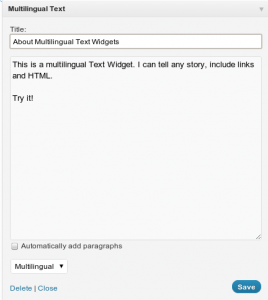We’re ready with a release candidate for WPML 2.3.0. This means, we think that everything is good, but we want to let you try it before doing the final release. It’s running fine for our sites.
WPML 2.3.0 is the result of 6 weeks of intensive work and includes a host of new features, as well as fixes to every problem reported since WPML 2.2.2.1.
Translation Management for String Translation
If you’re using both the String Translation and Translation Management modules, you’ve probably wondered why only the Admin can translate and not the designated translators.
Well, now it’s possible.
When both modules are enabled, you’ll see an option to select strings and translate them.

The strings that you’ve selected will appear for the translators that you setup with the Translation Management module.
They can see all strings, but only edit the ones that you’ve sent them. Both the Admin and translators can filter by strings that are still pending translation.
Of course, Admins can still edit all translations themselves.
Note: this RC doesn’t send notifications to translators when strings are selected for translation. The final release will include email notifications for String Translation too.
Admin Bar Language Switcher
WPML filters content by language. Until now, each Admin page had its own way for choosing content language. It was fine as long as it was supported. However, many plugins and theme admin pages also need to choose content. There was no way to tell which languages you want to show content in.
WPML 2.3.0 moves the content language filter to the WordPress Admin bar.

With this language switcher, you can choose which content to display on any page in the WordPress Admin. No more hacks and tricks to customize your site in different languages.
This new language switcher will also let you get the most out of the new WPML Media Translation plugin. When you go to the Media page, you’ll see each attachment once and not duplicated.
Multilingual Text Widget
Indeed, WPML hooks to the standard WordPress Text Widgets, but sometimes there are problems. These problems occur when other plugins filter the content of Text Widgets (like adding analytics tracking to outgoing links).
We’ve solved this, for good, by introducing our own Multilingual Text Widget. This widgets is everything-proof and translations will appear no-matter-what. We can guarantee that because of the way it works. Our widget registers strings by widget ID instead of their content. No matter what happens on the way, the ID is not going to change and translations are always associated with the correct widget.
It also has a handy feature that allows you to choose on which languages to display. A Multilingual Text Widget can appear on all languages (and you translate it via the String Translation screen), or for a specific language.

Auto Register Strings
While we’re on the subject of String Translation improvements, check out the new ‚Auto Register Strings‘ feature. It’s available in the String Translation screen:
If you’ve lost any hair over not finding where to translate strings, this might just help you grow it back.
The default is to have this feature disabled (too bad…). You can enable auto-registration for Admins (recommended) or always (use with caution).
When enabled, WPML will automatically register for translations strings that appear on the string, but don’t exist in the String Translation screen.
This can include anything, raging from theme texts to dynamically generated strings (which pass through some sort of filter, so that WPML can see them). Once auto-registered, you can translate them in the String Translation screen and they should appear on the page.
Note that as cool as it is, it still doesn’t solve every possible case. For instance, hard-coded strings that are not wrapped in gettext calls, or Admin strings that don’t pass through any WordPress filter, will not be auto-registered.
Much Improved Translation Editor
WPML’s Translation Editor got a big boost in this version. Now, both the original text and translation use iframes. This makes it completely safe to any content you can throw at it (just like the standard WordPress editor). Switching between Visual and HTML modes also works flawlessly and the copy from original does its job.
We’ve also added significant improvements for Right-to-Left and Left-to-Right editing to both the Visual and HTML modes.
WordPress 3.2
Have you noticed anything different in the screenshots in this post? We’re already using WordPress 3.2 in our testing. So far, everything seems to work smooth between WordPress 3.2 and WPML 2.3.0. We’re not checking every possible feature in WordPress itself, but everything related to languages works great for us.
Beware, WordPress 3.2 is addictive. If you switch to it for testing, you’re not going to give it up. Do some testing and make sure that nothing in your theme or other plugins fails with WP 3.2 before you venture with Beta versions.
Note: we’ve noticed a few glitches related with WordPress 3.2. We’ll have them sorted out by the final release of WPML 2.3.0. WordPress is still in Beta, so things can change.
Getting the Release Candidate
Owners of the Multilingual CMS package can login to their WPML account and click on Downloads. Scroll down to where it says Beta versions. The last version (b4, from today) is the release candidate.
If you’re upgrading from a previous Beta, you’ll need to force WPML to run the DB migration. Open PHPMyAdmin, edit the wp_options table, look for an entry called icl_sitepress_version and change it manually to 2.2.2.1. If you’re doing a fresh install, or upgrading from the previous production version, you don’t need to edit anything.
Yup, we’re running it on our sites now and we’re happy.
No, don’t switch to production sites before testing offline. What works for us (and passes tons of testing) may still have unexpected interaction with your site. Test before you upgrade.

